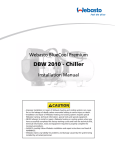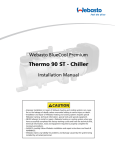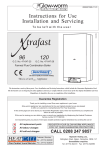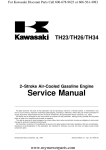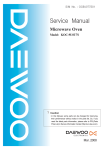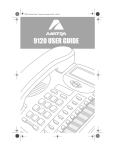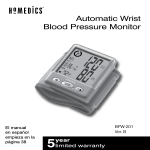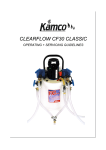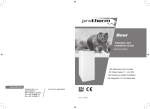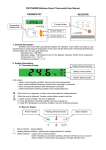Download Protherm 100 Technical data
Transcript
Wall hung combination boiler PROTHERM 100EC USER, INSTALLATION, AND SERVICING INSTRUCTIONS 4728 THIS IS A CAT II2H3+ APPLIANCE Technical Advice & After Sales Service 01773 828100 Protherm 100EC Note: The boiler serial number is marked on the data label attached to the fascia behind the front panel. Refer to the ‘Introduction’ section for a description of the basic functions of the boiler. The ‘User’ section describes how to safely operate the boiler. Users’ Instructions Introduction ............................................................................................................................ 2 Controls and lighting .............................................................................................................. 2 Draining and filling .................................................................................................................. 4 Heating safety valve .............................................................................................................. 4 Servicing/maintenance ........................................................................................................... 4 Cleaning ................................................................................................................................. 4 Boiler casing .......................................................................................................................... 4 Installation Instructions Introduction ............................................................................................................................ 5 Technical data ........................................................................................................................ 6 Dimensions ............................................................................................................................ 7 Pressure available ................................................................................................................. 7 Boiler schematic .................................................................................................................... 8 Installation section ................................................................................................................. 9 Terminal positions .................................................................................................................. 9 Heating and hot water system design .................................................................................. 10 Boiler installation ................................................................................................................ 11 Boiler template ..................................................................................................................... 12 Horizontal flue installation .................................................................................................... 13 Vertical flue installation ........................................................................................................ 14 Flue configurations ............................................................................................................... 15 Electrical connection ............................................................................................................ 16 Commissioning .................................................................................................................... 17 Servicing Instructions Routine cleaning and inspection ........................................................................................... Replacement of parts ........................................................................................................... Schematic wiring diagram .................................................................................................... Fault finding ......................................................................................................................... Conversion to LPG ............................................................................................................... 19 20 23 24 26 Mandatory warning for CE countries WARNING, these appliances were designed, approved and inspected to meet the requirements of the English market. The identification plate located on the inside of the appliance certifies the origin where the product was manufactured and the country for which it is intended. If you see any exception to this rule, please contact your nearest stockist. Thank you in advance for your assistance. 1 USERS INSTRUCTIONS The Protherm 100EC is a wall mounted combination boiler providing central heating and instantaneous domestic hot water. These instructions should be carefully followed for the safe and economical use of your boiler. Gas leak or fault If a gas leak or fault exists or is suspected, turn the boiler and gas supply off and consult the local gas company or your Installer/Service provider. In case of power supply failure The boiler no longer operates. As soon as power supply is restored, the boiler will restart automatically. In case of loss of water in the system CAUTION: The boiler is installed as part of a sealed system which must only be drained and filled by a competent person. If the pressure LED diod (2) flashes the pressure in CH system is less than 1 bar and the system must be filled up immediately. Important notice: A central heating system cannot operate satisfactorily unless it is properly filled with water and unless the air initially contained in the piping systems has been properly bled off. If these conditions are not satisfied, air noise will occur within the system and the boiler may fail to operate. Air in the heating system Persistent air in the heating system may indicate leaks in the system or corrosion taking place. Call your Installer /Service provider. Overheating safety In the event of problem, the overheat safety device causes safety shutdown of the boiler. If this happens, call your Installer/Service provider. CONTROLS AND LIGHTING The control panel is located at the lower front of the boiler casing. The controls on this panel allow the boiler to be started, shut down, controlled and monitored during use, see diagram 1. Controls: 1 – mains on/off switch 2 – system pressure LED 3 – central heating LED 4 – domestic hot water LED 5 – timeclock 6 – increase button 2 7 – pressure button 8 – reset button 9 – decrease button 10 – comfort mode LED 11 – mode button 12 – display Diagram 1 The following information is displayed: • Actual heating temperature (°C) - LED (3) lights on displayed during standby • Actual domestic hot water temperature (°C) - LED (4) lights displayed during hot water demand • System pressure (bar) – LED (2) lights for 25 sec after Bar button is pressed • Diagnostic messages – displayed letter F and numbers from 0 to 4 Make sure that: • The boiler is connected to the electrical supply. • The boiler gas service cock is open. • The CH system is filled up and pressurized between 1 and 2 bar. The boiler is now ready to start. To start the boiler Switch on the mains switch (display will light up). The version of the software used is displayed for 2 sec. To stop the boiler Switch off the mains switch (display will go out). If the boiler is to be out of operation for a long period, turn off the gas service cock. Boiler setting All parameters are adjustable by means of 3 buttons, pushing the RESET button restarts the boiler. Note: Buttons must be pressed in the middle. Domestic hot water setting • Press Mode button until LEDs (4) flash. • Using buttons (6) and (9) set the desired hot water temperature. Setting steps: 40, 42, 45, 48, 50, 52, 55, 58, 60 °C • Set ´– –´ if hot water is not required. • Press Mode button to save new setting. Heating setting / summer mode setting • Press Mode button until LED (3) flashes. • Using buttons (6) and (9 set the desired heating temperature. Setting steps: 45, 50, 55, 60, 65, 70, 75, 80, 85 °C • Set ´– –´ if only hot water is required (summer mode). • Press Mode button to save new setting. The heating will operate according to the requirements of the timeclock and/ or room thermostat if fitted or, will operate according to the system requirements. Domestic hot water (DHW) always has priority over central heating (CH). Note: All new settings are stored by pressing MODE button. If MODE button is not pressed for 20 sec the display reverts to standby mode and old settings are retained. Helpfull hint If you get confused and wish to start again, switch boiler off, press and hold button (9) and switch boiler on by main switch. The boiler will revert to the internal factory set programme (heating temperature 80 °C, hot water temperature 50 °C, maximum heat output). Timeclock The boiler can be switched on and off automatically by the built-in timeclock. To set the timeclock, proceed as follows: (refering to diagram 1). Press in the tappets corresponding to the time you want the boiler to be on. For example if you want the boiler to be on between 7 AM and 9 AM, push in all the tappets between 7 and 9. Set the times you want the boiler to be on for the rest of the day in the same way. Note: The timeclock setting is in 24 hour format. Therefore, if you want the boiler to come on at 2 PM you must push in the tappets at 14. 3 To set the correct time rotate the clock by hand until the current time is indicated by the arrow at the top of the clock. To operate the boiler according to your selected times, place the grey lever to the position. To have the boiler permanently ‘ON’, place the grey lever to the ‘I’ position. To have the boiler permanently ‘OFF’, place the grey lever to the ‘0’ position. The comfort mode of domestic hot water Comfort mode means that boiler is kept in pre-heated stage and waiting time for DHW delivery is shorten. There are two ways of comfort DHW mode available: Limited - if comfort mode of hot water is required only for limited time. Open and close a bath tap (On/Off for interval between 2 and 5 seconds). It is automatically recognized by boiler control unit and primary system water is preheated for immediate hot water preparation. Permanent - if comfort mode of hot water is required permanently. Be sure, the display is in basic mode. Press button (6). Comfort LED (10) will light up - comfort mode is ON. Comfort mode will OFF by next press of button (6) - diode (10) will go out. Safety lockout In the event of a safety lockout, the digital display will show ‘F1’. Reset boiler by pressing the RESET button. IMPORTANT: If safety lockout occurs frequently, or if any other fault is indicated, contact your Installer/Service Provider. DRAINING AND FILLING CAUTION: The boiler is installed as part of a sealed system which must only be drained and filled by a competent person. If the pressure drops to 1 bar the pressure LED on the Bar button starts to flash. The boiler will continue to work, but the LED warns that pressure in the CH system is on the low limit and CH system must be filled. To fill the system, open the tap on the filling loop below the boiler. Press the Bar button to read the system pressure. When the pressure is between 1 and 2 bar, close the tap. Note: If there is persistent loss of system pressure, you must consult your Installer/Service Provider. HEATING SAFETY VALVE CAUTION: A safety valve with a discharge pipe is fitted to this boiler. The valve MUST NOT BE TOUCHED except by a competent person. If the valve discharges at any time, switch the boiler off and isolate it from the electrical supply. Contact your Installer/Service Provider. SERVICING / MAINTENANCE To ensure the continued efficient and safe operation of the boiler, it is recommended that it is checked and serviced at regular intervals. The frequency of servicing will depend upon the installation conditions and usage but, in general, once a year should be enough. CLEANING The boiler casing can be cleaned with a damp cloth followed by a dry cloth to polish. Do not use abrasive or solvent cleaners. BOILER CASING CAUTION: Do not remove or adjust the casing in any way, as incorrect fitting may result in faulty operation. If in doubt, contact your Installer/Service Provider. 4 INSTALLATION INSTRUCTIONS INTRODUCTION The Protherm 100EC is a wall mounted combination boiler providing central heating and instantaneous domestic hot water. The boiler is of the II2H3+ category for use with Natural gas (G20) as distributed in the United Kingdom, or with Butane or Propane gas (G30/G31) with the appropriate conversion kit. Conversion kit: Conversion Natural gas (G20) to G30/G31 Modification must only be carried out by a suitably qualified engineer. Boilers burning LPG or similar gases MUST NOT be fitted in basements or below ground level. These instructions should be carefully followed for the safe and economical use of your boiler. The boiler has a fan assisted, balanced, flue which both discharges the product of combustion to, and draws the combustion air from the outside of the building. Accessories A range of accessories are available including, vertical flue components. For further information, contact you nearest stockist. Gas Safety (Installation and Use) Regulations In the interests and that of gas safety, it is the law that ALL gas appliances are installed and serviced in by a competent person in accordance with the above regulations. Gas leak or fault If a gas leak or fault exists or is suspected, turn the boiler and gas supply off and consult the local gas company or your Installer/Service Provider. Boiler controls The control panel, located at the lower front of the boiler, allows the boiler to be started, shut down, controlled and monitored during use, refer to ‘Users Instructions’. 5 TECHNICAL DATA CE Certification .............................................. n° ............................................................... 49AU2915 Class .......................................................................................................................................... II2H3+ Type ........................................................................................................................................ C12, C32 Gas type ....................................................................................... G20 ............... G30 ................. G31 Max. / min. heat input .................................... kW ..................... 30.5/12.1 ....... 30.5/12.1 ..... 30.5/12.1 Max. / min. heat output ................................. kW ..................... 27.4/10.0 ....... 27.4/10.0 ..... 27.4/10.0 EFFICIENCY (PCI) Nominal efficiency .......................................... % ........................................................................ 89.8 Efficiency at 30% load .................................... % ........................................................................ 86.7 HEATING Temperature range ......................................... °C .................................................................... 45 – 85 Expansion vessel ............................................. l ............................................................................. 7 Expansion vessel pressure ........................... bar ............................................................................. 1 Max. working pressure .................................. bar ............................................................................. 3 Max. system temperature .............................. °C ........................................................................... 85 Max. system capacity ....................................... l ..........................................................................130 HOT WATER Flow rate at 30°C temperature rise .............. l/min ........................................................................ 13.1 Flow rate at 35°C temperature rise .............. l/min ........................................................................ 11.3 Min. water flow ............................................ l/min ............................................................................. 2 Max. / min. supply pressure .......................... bar ........................................................................ 6 / 1 Temperature range ......................................... °C .................................................................... 40 – 60 ELECTRICAL DATA Voltage / frequency .................................... V/Hz ................................................................ ~230 / 50 Current ............................................................. A .......................................................................... 0.8 Power .............................................................. W ..........................................................................160 Level of protection .......................................... IP ....................................................................... IP 44 DIMENSIONS Width / height / depth ................................... mm .......................................... .............450 / 800 / 355 Weight ........................................................... kg ........................................................................... 42 CONNECTIONS Heating flow / return ..................................... mm ........................................................................... 22 Domestic Water inlet / outlet ........................ mm ........................................................................... 15 Gas .............................................................. mm ........................................................................... 22 Flue products outlet / air inlet ∅ ..................... mm ....................................... horiz. 60/100, vert. 80/125 Horizontal flue length min. – max. ................... m .................................................................... 0.3 – 3 Vertical flue length min. – max. ....................... m ................................................................ 0.5 – 11.5 GAS SUPPLY PRESSURE Burner pressure ......................................... mbar ..................... 2.1 – 15.0 ..... 3.8 – 28.8 .... 4.1 – 36.7 Nominal pressure ....................................... mbar ........................... 20 ................. 29 ..................... 37 Injectors diameter .................................... ∅ mm .......................... 1.2 .............. 0.73 ................ 0.73 GAS CONSUMPTION 3 Q max / Q min ............................................ m /h ...................... 3.2 / 1.3 ....... 1.1 / 0.5 ....... 1.4 / 0.6 3 Air flow ........................................................ m /h .......................... 135 ............... 135 ................... 135 6 DIMENSIONS AND PRESSURE AVAILABLE Diagram 2 1 – Heating flow (pipe diameter 22 mm) 2 – Hot water outlet (pipe diameter 15 mm) 3 – Gas inlet (pipe diameter 22 mm) 4 – Cold water mains inlet (pipe diameter 15 mm) 5 – Heating return (pipe diameter 22 mm) 6 – Wall 7 – Wall fixings 8 – Outer cover Diagram 3 7 BOILER SCHEMATIC 1 – Air pressure switch 2 – Fan 3 – Combustion chamber 4 – Heat exchanger 5 – Burner 6 – Gas valve 7 – Expansion vessel 8 – Pump 9 – Water flow sensor 10 – Safety valve 11 – Heating return 12 – Domestic cold water inlet 13 – Gas inlet 14 – DHW thermistor 15 – DHW outlet 16 – Automatic by-pass 17 – Heating flow 18 – Drain point 19 – Water pressure sensor 20 – 3-way valve 21 – Actuator 22 – Domestic heat exchanger 23 – CH temperature sensor 24 – High limit thermostat Diagram 4 8 INSTALLATION SECTION Clearances To allow for servicing, the boiler should be installed with the following clearances: 50 mm either side of the boiler 600 mm to the front of the boiler 300 mm below the boiler 200 mm above the boiler TERMINAL POSITION The minimum acceptable spacings from the terminal to obstructions and ventilation openings are shown in diagram 5 below: Diagram 5 Minimum dimensions (in mm) for the positioning of flue terminals a b c d e f g h i l m n Under a window . . . . . . . . . . . . . . . . . . . . . . . . . 300 Under an air vent . . . . . . . . . . . . . . . . . . . . . . . 300 Under a gutter . . . . . . . . . . . . . . . . . . . . . . . . . . . 75 Under a balcony . . . . . . . . . . . . . . . . . . . . . . . . 300 From an adjacent window . . . . . . . . . . . . . . . . . 300 From an adjacent air vent . . . . . . . . . . . . . . . . . 300 From vertical drain pipes or soil pipes . . . . . . . . . 75 From an external corner of the building . . . . . . . 300 From an internal corner of the building . . . . . . . . 300 From the ground or from another floor . . . . . . . . 300 Between two terminals vertically . . . . . . . . . . . 1500 Between two terminals horizontally . . . . . . . . . . 300 9 HEATING SYSTEM DESIGN The Protherm 100EC is compatible with any type of sealed system installation, i.e. radiators, fan convectors etc. Pipe sectional areas shall be determined in accordance with normal practices, using the pump curve, refer to ‘Technical Data’. The distribution system shall be calculated in accordance with the output requirements of the actual system, not the maximum output of the boiler. However, provision shall be made to ensure sufficient flow so that the temperature difference between the flow and return pipes is less than or equal to 20 °C. The minimum flow is 500 l/h. The piping system shall be routed so as to avoid any air pockets and facilitate permanent venting of the installation. Bleed fittings shall be provided at every high point of the system and on all radiators. The total volume of water permitted for the heating system depends, amongst other things, on the static head in the cold condition. The expansion vessel on the boiler is pressurised at 1 bar (corresponding to a static head of 10 m wg.) and allows a maximum system volume of 130 litres for an average temperature of 75 °C and a maximum service pressure of 3 bar. This pressure setting can be modified at commissioning stage if the static head differs. Provision shall be made for a drain valve at the lowest point of the system. Thermostatic radiator valves are permitted, however, not all radiators must be fitted with this type of valve and particularly where the room thermostat is fitted. A WRC approved filling loop is supplied with the boiler to enable correct filling of the system. In all cases, it is ESSENTIAL that the system be thoroughly flushed prior to installing the new boiler. Domestic hot water system design Copper tubing or plastic Hep2O may be used for the domestic hot water system. Unnecessary pressure losses should be avoided. The domestic hot water supply pressure must be between 1 and 6 bar. If the pressure exceeds 6 bar, a pressure reducing valve must be fitted. In known hard water areas, it is recommended that a suitable scale reducing device is fitted to the cold water supply to the boiler. Boiler connections A B C D E F Heating flow Hot water outlet Gas connection Cold water mains inlet Heating return Safety valve discharge connection Heating system connections - Pipe diameter 22 mm. Hot water system connections - Pipe diameter 15 mm. Gas connection - Pipe diameter 22 mm. Safety valve discharge connection - Pipe diameter 22 mm. Note: White colored washers must be used for the hot water system connections. 10 Diagram 6 Safety valve discharge WARNING: It must not discharge above an entrance or window or any type of public access area. Connect the safety valve discharge pipe to the valve, the discharge must be extended using not less than 15 mm o.d. pipe, to discharge in a visible position outside the building, facing downward, preferably over a drain. The pipe must have a continuous fall and be routed to a position so that any discharge of water, possibly boiling or steam, cannot create any danger to persons, damage to property or external electrical components and wiring. Tighten all pipe connection joints. Gas connection The supply from the governed meter must be of adequate size to provide a constant inlet working pressure of 20 mbar for Natural gas (28 – 30 mbar for Butane or 37 mbar for Propane). To avoid low pressure problems, it is recommended that the supply is taken to the boiler using 22 mm pipe as far as possible. On completion, the gas installation must be tested using the pressure drop method and purged in accordance with the current issue of BS6891. Gas Safety (Installation and Use) Regulations In your interests and that of gas safety, it is the law that ALL gas appliances are installed and serviced by a competent person in accordance with the above regulations. Statutory requirements The installation of this boiler must be carried out by a competent person in accordance with the relevant requirements of the current issue of: The Gas Safety (Installation and Use) Regulations The Building Regulations The local water company Bylaws The Building Standards Regulations (Scotland) The Health and Safety at Work Act Sheet metal parts WARNING: When installing or servicing this boiler, care should be taken when handling the edges of sheet metal parts to avoid the possibility of personal injury. Installing the boiler Prior to installing the boiler, the system must be thoroughly flushed to eliminate any foreign bodies and contaminents such as filings, solder, particles, oil, grease etc. Note: Solvent products could cause damage to the system. BOILER INSTALLATION To install the boiler, proceed as follows: • Allowing sufficient clearances for servicing/repair, place the template on the wall (see diagram 7). Note: The boiler can be installed only on the closed wall. • Determine the position of the flue hole and drill hole for flue, preferably using a 120 mm core drill. • Drill two 10 mm holes for the wallplugs supplied. • Screw fixing screws supplied into wallplugs, leave proud by approx. 10 mm. Note: Boiler fixing holes are keyhole type slots at the top of the boiler to allow easy hanging of boiler. • Remove template. • Hang the boiler on the screws and tighten screws. Note: As a option the hanging bracket can be used. Two screws are sufficient for fixing of the hanging bracket. Hanging bracket fixing screws have to be fully tight before the boiler is hung on. Pipework connections • Remove plastic caps from boiler connections. • Connect the central heating pipework connections and isolating cocks as shown on diagram 6. • Connect the domestic cold water inlet connection and isolating cock. • Connect the hot water outlet connection. • Connect the safety valve discharge pipe. • Finally, connect the gas connection and isolating cock. 11 BOILER TEMPLATE Boiler connections A Heating flow B Hot water outlet C Gas connection D Cold water mains inlet E Heating return F Safety valve discharge connection Diagram 7 12 HORIZONTAL FLUE INSTALLATION A B C D E F G I J K Air inlet pipe Terminal Seal and clamp Elbow Gasket Screws External rubber sealing collar Internal plastic collar ‘O’ rings Spacer (see diagram 9) • • • • • • • Fit gasket (E) onto underside of flue elbow (D). Diagram 8 Carefully insert ‘O’ ring (J) into upper and lower parts of inner elbow. Place spacer (K) (supplied with boiler) onto top of boiler (see diagram 9). Fit elbow onto spacer ensuring elbow inner connection locates correctly onto fan outlet. Fit external rubber sealing collar (G) onto air inlet pipe (A). Fit flue through hole in wall and pull up so that external collar (G) is flush against outside wall. Fit seal and clamp (C) to flue and assemble into elbow (D) making sure that both inner and outer pipes are sealed properly. Note: Maximum horizontal length with no bends is 3 m. For horizontal flue lengths up to 1 m the restrictor must be left in the fan outlet, see diagram 9. For horizontal flue lengths between 1 and 3 m, remove the restrictor (R). • Tighten up clamp using screws provided. Note: Should it be necessary to cut the flue, always cut equal amounts from both inner and outer pipes. Always cut the end furthest from the terminal. For each 90° flue bend fitted, reduce overall flue length by 1 m. For each 45° flue bend fitted, reduce overall flue length by 1/2 m. Horizontal flue kit Flue extension kit 90° concentric bend kit 45° concentric bend kit 85090 85091 85092 85093 Diagram 9 Standart top outlet flue Standart top outlet flue 90° elbow Extension pipe 13 VERTICAL FLUE INSTALLATION • • • • • • • • Fit gasket (E) onto underside of vertical adaptor (O) – see diagram 10. Carefully insert ‘O’ ring (J) into vertical adaptor inner spigot. Place spacer (K) on the top of boiler. Fit vertical adaptor (O) onto spacer (K) ensuring adaptor inner connection locates correctly onto fan outlet. For flat roof installation, fit flat roof flashing collar (part no. 85107) Fit extension pipes (M) as required. For pitch roof installation, fit pitch roof flashing (part no. 85105). Fit flue terminal (L) onto roof ensuring flashing makes a watertight joint. Note: Maximum vertical height with no bends is 5 m. Should it be necessary to cut the flue, always cut equal amounts from both inner and outer pipes. Connect condensate trap (supplied) to vertical flue adaptor when flue length exceeds 3 m. Connect 15 mm plastic pipe (not supplied) to a suitable drain. For vertical flue lengths up to 3 m the restrictor must be left in the fan outlet, see diagram 9. For vertical flue lengths between 3 and 5 m, remove the restrictor (R). For each 90° flue bend fitted, reduce overall flue height by 1 m. For each 45° flue bend fitted, reduce overall flue height by 1/2 m. Vertical flue terminal (black) Vertical flue terminal (brick) Pitched roof flashing Flat roof flashing Flue extension pipe 90° concentric bend kit 45° concentric bend kit 85103 85104 85105 85107 85099 85101 85102 Diagram 10 14 FLUE CONFIGURATIONS Diagram 11 15 ELECTRICAL CONNECTION Warning: This boiler must be earthed. All system components must be of an approved type. Connection of the whole electrical system and any heating system controls to the electrical supply must be through a common isolator. Isolation should preferably be by a double pole switched fuse spur box having a minimum contact separation of 3 mm on each pole. The fused spur box should be readily accessible and preferably adjacent to the boiler. It should be identified as to its use. A fused three pin plug and shuttered socket outlet may be used instead of the fused spur box, provided that: a) They are not used in a room containing a bath or shower. b) Both the plug and socket comply with the current issue of BS1363. The mains electrical supply must be maintained at all times in order to provide domestic hot water and frost protection. It is recommended that a room thermostat is fitted. Thermostatic radiator valves may be installed in addition to the room thermostat. Note: For further information, see The Building Regulations 1991 - Conservation of fuel and power - 1995 edition - Appendix G, table 4b. DO NOT INTERRUPT THE MAINS SUPPLY TO THE BOILER WITH A TIME SWITCH OR PROGRAMMER. The Protherm 100EC is delivered with 1metre mains supply lead ready connected. The electrical supply cable is the original spare part and must be replaced only by original supply cable for Protherm 100EC boiler. External controls The boiler will work for heating AS DELIVERED without a room thermostat fitted provided the two wires on the integral external controls connection REMAIN LINKED TOGETHER (as supplied). If a room thermostat is required, it must be connected as shown below and the link must be removed. ANY ROOM THERMOSTAT USED MUST BE OF THE VOLTAGE FREE TYPE. Diagram 12 WARNING: ON NO ACCOUNT MUST ANY ELECTRICAL VOLTAGE BE APPLIED TO EITHER OF THE TERMINALS OF THE EXTERNAL CONTROLS CONNECTION WARNING: This boiler must be wired in accordance with these instructions. Any fault arising from incorrect wiring cannot be put right under the terms of the guarantee. 16 COMMISSIONING The commissioning and first firing of the boiler must only be carried out by a competent person. To gain access to the inside of the boiler undo screw securing front panel at the boiler bottom, remove front panel by pulling forwards, lifting it up and off. Note – upper edge of front casing is fixed to the boiler by means of 2 pins. Gas installation It is recommended that any air is purged from the supply at the gas inlet test point on the gas valve, see diagram 13. 1 - Inlet test point 2 - Outlet test point Filling the system • Check that the gas meter tap is closed. • Conect boiler to electrical supply. • Place switch (1) diagram 1 to possition “I”. F0 is displayed and the pump runs for about one minute. • Press the BAR button, see diagram 1. Value of system pressure (0.0) is displayed Diagram 13 and LED (2) – see diagram 1 – lights. Note: The pressure is displayed for about 25 sec. After this time the display comes back to the standby mode. The pressure can be displayed after pressing Bar push button again. • Open isolating valves (A, E and D) see diagram 6. • Undo, but not remove, cap on automatic air vent on the top of the pump. • Fill system by opening system filling loop until a pressure of between 1 and 2 bar is shown on the display. • Bleed each radiator until a continuous jet of water is obtained. • Do not retighten automatic air vent cap. • Open various hot water taps to bleed hot water circuit. • Make sure that pressure is between 1 and 2 bar. Re-pressure as necessary. Important: When venting air from boiler, do not touch the schrader valve on the expansion vessel, it is NOT a vent. Starting the boiler Before starting the boiler check that: - The gas meter tap is open. - The boiler gas service cock is open. - The water isolating cocks are open. - The boiler is connected to the electrical supply. First starting up • Place main switch (1) diagram 1 to position “I”. • Set maximum heating water temperature (85°C), as described in ‘Users Instructions’ and check that any external controls, if fitted, are calling for heat. • Allow the temperature to rise to the maximum value, with all radiator valves open. Air contained in the water of central heating system will be automatically released through the automatic air vent. Air trapped at the hightest point of the system must be released by bleeding the radiators. On reaching maximum temperature, the boiler should be turned off and the system drained as rapidly as possible whilst still hot. • Refill system to a pressure at least of 1 bar and vent as before. • Restart boiler and operate until a maximum temperature is reached. Shut down boiler and vent air from heating system. If necessary, top up heating system and make sure that a pressure at least of 1 bar is indicated on the display when system is COLD. Gas pressures • Shut down boiler. • Undo screw on gas inlet test point ‘1’ on gas valve, see diagram 13. • Connect a suitable pressure gauge. • Start boiler as described in ‘Users Instructions’. 17 • Check that there is a constant pressure of 20 mbar for Natural gas (28 – 30 mbar for Butane or 37 mbar for Propane). If the pressure is insufficient, it is necessary to check the gas supply/pipework and correct any fault. • Shut down boiler. • Remove pressure gauge, tighten up carefully test point screw and check for gas soundness. Setting the central heating output The central heating output must be set in accordance with the system requirements. Setting procedure as follows: • Push and hold the Mode button for at least 8 sec. The display will switch to service mode, the symbol nwill be displayed • Set the desired output value from n1 to n9 by means of buttons (6) and (9) according to the following table: n1 n2 n3 n4 n5 ..... ..... ..... ..... ..... kW 9.3 . . . . . 11.0 . . . . . 12.0 . . . . . 14.0 . . . . . 16.0 . . . . . Btu/hr 31 732 37 532 40 944 47 768 54 592 n6 n7 n8 n9 n- .... .... .... .... .... kW Btu/hr 18.0 . . . . . 61 416 20.0 . . . . . 68 828 22.5 . . . . . 76 770 23.3 . . . . . 79 499 23.3 . . . . . 79 499 (max. output) • Press Mode button to save and return to main menu. Safety devices Diagram 14 Air flow rate safety device If an obstruction, even partial, of the flue occurs, the built in safety system of the boiler will turn the boiler OFF. The boiler will be ready to operate when the fault has been cleared. In case of power supply failure The boiler no longer operates. As soon as power is restored, the boiler will be automatically restarted. If the boiler does not restart, the overheat device may need resetting. Overheat safety In the event of overheating, the overheat safety device causes safety shutdown of the boiler. The digital display will show error code F1. To reset, let the boiler cool down, press the reset button on the safety device (a), see diagram 22 and reset boiler controls by means of the reset button (8). Note: wire connections to overheat thermostat are mains voltage. Important notice A central heating system cannot operate satisfactorily unless it is properly filled with water and unless the air initially contained in the pipework system has been properly bled off. If these conditions are not satisfied, air noise will occur within the system and the boiler may fail to operate. To reset the boiler (other than for overheating) use the reset button on the fascia, see diagram 15. Diagram 15 The Protherm 100EC boiler has a built-in frost protection device that protects the boiler during freezing conditions. This device works irrespective of any room thermostat setting and only protects the boiler. Should the temperature within the central heating circuit of the boiler fall below 10 °C, the pump will switch on providing the electrical supply has been left connected. If the temperature falls below 8 °C, then the burner will operate until the water temperature increases to 25 °C. Should the electrical supply have been disconnected and the boiler/system has frozen, the boiler will not start up until the boiler/system has been cleared. 18 SERVICING INSTRUCTIONS To ensure the continued efficient and safe operation of the boiler, it is recommended that it is checked and serviced at regular intervals. The frequency of servicing will depend upon the installation conditions and usage but, in general, once a year should be enough. It is the law that any servicing is carried out by a competent person. ROUTINE CLEANING AND INSPECTION • • • Operate boiler and check for any faults that need to be put right. Isolate boiler from the gas and electrical supplies. On completion check all gas carrying parts for soundness with leak detection fluid. Remove boiler casing as follows: Outer casing • Undo screw securing the casing underneath boiler and remove outer casing by pulling forwards, lifting it up and off. Sealed chamber • Unclip two clips holding sealed chamber cover to boiler and lift it forwards and off. Side covers • Undo 3 screws securing each of side covers and remove outer covers by pulling to side, forwards and off. Sealed chamber • Unclip two clips holding sealed chamber cover to boiler and lift it up and off, see diagram 16. Cleaning the burner • Unscrew and remove 6 screws securing combustion chamber cover and remove cover. • Disconnect flame sense electrode at burner. • Disconnect ignition lead at gas valve module. • Disconnect ignition earth lead. • Undo nuts (A) securing gas supply pipe between burner and gas valve and remove pipe, see diagram 17. Note: The washer between the burner and burner gas supply must be kept to use on reasembly. • Unscrew 2 screws (B) securing burner to base of sealed chamber. • Pull main burner up and forward out of boiler. • Examine and clean burner as necessary. Diagram 16 Note: DO NOT use a wire or sharp instrument on the holes. Heat exchanger • Locate the heat exchanger inside the sealed chamber. • Gain acces to heat exchanger by removing fan and flue hood. • Examine heat exchanger for any blockages or build up of deposits. • Clean heat exchanger with soft brush or vacuum cleaner. Diagram 17 Reassembly of parts removed for servicing All parts are replaced in reverse order to removal. Flue system • Check externally to make sure that flue is not blocked. • Inspect flue system to make sure that all fittings are secure. Operation of fan • Switch on electrical supply and turn on gas. • Remove sealed chamber cover. • Light burner by operating external controls (if fitted) to call for heat. • Check that fan operates when burner lights and stops when it goes out. 19 REPLACEMENT OF PARTS To gain access to the boiler components, proceed as follows: • Isolate boiler from electrical supply. • Remove outer case, if necessary sealed chamber cover, combustion chamber cover and side covers, see “Routine cleaning and inspection”. • Gently squeeze metal clip securing the control panel box, lift it up and hinge down. To replace fan • Disconnect power supply and earth leads to fan. • Supporting fan, unscrew and remove two screws securing fan to front of flue hood, see diagram 18. • Gently ease fan forwards and out of boiler. • Fit replacement fan in reverse order to removal making sure that mounting plate engages correctly onto flue hood Important: Ensure that fan outlet is correctly fitted into flue elbow at top of boiler. To replace air pressure switch • Locate air pressure switch in upper left hand corner of sealed chamber. • Pull off clear plastic tube from base of switch. • Remove electrical connections from switch. • Unscrew and remove two screws securing switch to upper panel and remove switch – (or unclip air pressure switch from plastic holder – depends on type of switch used). • Fit electrical connections to replacement switch as follows: One to the microswitch connection marked ‘NO 2’ One to the microswitch connection marked ‘COM 3’ • Fit replacement switch in reverse order to removal. Important: Refit clear plastic tube as follows: Tube from tapping point of flue hood to switch point ‘P 2 -’ To replace gas valve module • Locate gas valve module attached to side of gas valve, see diagram 19. • Unscrew screw (a) securing cover onto gas valve module. • Remove cover and disconnect multi-plug from module. • Disconnect ignition and flame sense leads from module and withdraw module from gas valve. • Fit replacement module in reverse order to removal. • Reconnect ignition and flame sense leads, the connections are uniquely sized to ensure correct replacement. • Refit cover ensuring all sealing grommets are correctly located in module body. Diagram 18 Diagram 19 To replace gas valve • Ensure that gas supply is turned off at gas cock. • Unscrew screw (a) and remove gas valve module. • Undo nuts securing gas supply pipe between burner and gas valve and remove pipe, taking care not to lose sealing washers, see diagram 19. • Remove gas inlet connection to boiler. • Unscrew 2 screws securing gas valve to boiler bottom. • Remove gas valve by lifting upwards and out of boiler. • Fit replacement gas valve in reverse order to removal. • Check for gas-tightness. To replace burner • Remove burner as described in ‘Cleaning the burner’. • Fit replacement burner in reverse order to removal. • Check if the injectors are correct. 20 To replace pump Drain down heating circuit only of boiler as follows: • From below boiler, close isolating valves on flow and return connections to boiler. • Open boiler drain valve on left hand side of hydraulic block. Note: It is not necessary to drain down entire heating circuit to carry out this work. Simplification: for simpler work remove gas valve module and right side cover. • Disconnect pump cable. • Remove 2 clips fixing pump, see diagram 20. • Unscrew 2 screws securing the pump to boiler bottom. • Lift up the pipe and remove pump by lifting forward and out of boiler. • Fit replacement pump in reverse order to removal. • Open isolating valves on flow and return connections. • Refill, vent and pressurise boiler. Check for leaks. Diagram 20 To replace safety valve • Drain down heating circuit of boiler as described previously. Simplification: for simpler work remove gas valve module and pump as described previously. • Remove expansion vessel hose from hydraulic block. • Remove draining pipe from safety valve and unscrew safety valve. • Fit replacement safety valve in reverse order to removal. Important: Seal the safety valve thread by jointing compound. To replace domestic heat exchanger • Drain down heating circuit of boiler as described previously. Drain down hot water circuit of boiler as follows: • From below of boiler, close cold water inlet isolating valve. • Open a hot tap to drain hot water circuit. • Remove gas valve. • Unclip pump and pull forwards. • Disconnect expansion flexible hose at connection to vessel fixing. • Remove fixing screws and plate exchanger over hydraulic block, see diagram 21. • Fit replacement heat exchanger in reverse order to removal, ensuring seals are correctly positioned in hydraulic block. • Open isolating valves on flow and return connections, refill, vent and pressurise boiler. Check for leaks. • Open cold water isolating valve. Check for leaks. Diagram 21 To replace overheat thermostats Important: Isolate boiler from electrical supply before this operation – connections to overheat thermostats are mains voltage. • Locate overheat thermostats (a) and (c) to left hand side of sealed chamber above thermistor, see diagram 22. • Unclip thermostat from pipe. • Pull off electrical connections from thermostat. • Fit replacement thermostat in reverse order to removal. Note: No heat sink compound is required. The polarity of the connections is not important. Diagram 22 21 To replace heating water thermistor • Locate thermistor (b) clipped onto flow pipe to left hand side of sealed chamber below overheat thermostat, see diagram 22. • Unclip thermistor from pipe. • Pull off electrical connections from thermistor. • Fit replacement thermistor in reverse order to removal. Note: No heat sink compound is required. The polarity of the connections is not important. To replace hot water thermistor • Pull off electrical connections from thermistor and unscrew thermistor (b) from left part of hydraulic block, see diagram 21. • Remove gas valve module as described previously. • Fit replacement thermistor in reverse order to removal. Note: The polarity of the connections is not important. To replace printed circuit board (PCB) Important: Isolate boiler from electrical supply before this operation. • Gently squeeze metal clip securing the control panel box, lift it up and hinge down. • From behind control panel box, unscrew and remove 4 screws securing PCB cover to panel. • Pull off electrical plugs from PCB. • Remove 4 screws securing PCB to panel and lift out PCB. • Fit replacement PCB in reverse order to removal. To replace display and control panel board Important: Isolate boiler from electrical supply before this operation. • Remove PCB cover as described in ‘To replace PCB’. • Pull off electrical plug of display (A) from PCB, see diagram 23. • Remove 4 screws securing PCB to panel and lift out PCB. • Remove 4 screws securing display and control panel bord to panel and gently lift it out. • Fit replacement display and control panel board in reverse order to removal. To replace timeclock • Remove PCB cover as described in ‘To replace PCB’. • Disconnect clock electrical connections from PCB. Unclench plastic clips securing timeclock to lower front panel and remove timeclock from panel. • Fit replacement timeclock in reverse order to removal. Diagram 23 To replace pressure gauge • Drain boiler as described in ‘To replace pump’. • Unclip pressure gauge clip and pull it out. • Disconnect pressure gauge cable. • Fit replacement pressure gauge in reverse order to removal. To replace heat exchanger • Drain down heating circuit of boiler only as described previously. • Remove sealed and combustion chamber covers and side cases as described previously. • Remove overheating termostats from heat exchanger pipes. • Pull off spring clips securing heat exchanger pipes to heat exchanger. • Manoeuvre heat exchanger pipes down to disengage from heat exchanger. • Remove heat exchanger by sliding forward and out of boiler. • Fit replacement heat exchanger in reverse order to removal. • Open isolating valves on flow and return connections, refill, vent and pressurise boiler. Check for leaks. 22 Diagram 24 SCHEMATIC WIRING DIAGRAM Diagram 25 23 FAULT FINDING Before fault finding, make sure that: - All gas cocks are open and there is an inlet gas pressure of 20 mbar (G 20). - The heating system pressure is at least 1 bar. - There is a permanent mains supply to the boiler. - The fuses on the PCB are intact. - All external controls are correctly wired and calling for heat. WARNING: Always isolate the boiler from the electrical supply before carrying out any electrical replacement work. Always check for gas soundness after any service work. Digital display shows: - CH temperature (no decimal point displayed) - DHW temperature (decimal point displayed) - diagnostic error messages - pressure in CH system - boiler output setting As soon as the mains switch is on the display shows for a very short time the version of software used. It has no importance for boiler operation. Diagnostic error messages In the event of a fault the following diagnostic error messages will be displayed: Message Fault Action Comments F0 Loss of system water Refill system Check for leaks Pump runs for one minute Boiler is restarted by switching of main switch Air lock in boiler Pressure sensor failure F1 No flame detected Overheating of the boiler F2 Central heating thermistor failure CH water temperature below 3°C Bleed boiler and system Check the pressure sensor (Sensing inlet must not be clogged) Check flame sense electrode and connecting cable Check ignition electrode Check ignition unit on gas valve Check fan operation Reset overheat thermostats Check the pump revolution If overheat thermostats are blocked, boiler does not ignite when starting Check if flow thermistor is not disconnected or short-circuited Sensor Ohm resistance 10 kΩ by 25°C, 12,7 kΩ by 20°C, 16 kΩ by 15°C Check if system is not frozen F3 Heat exchanger blockage Check main heat exchanger Check domestic heat exchanger Boiler shuts down and pump runs F4 Domestic hot water thermistor faulty Check thermistor/leads Sensor Ohm resistance: 10 kΩ by 25°C 12,7 kΩ by 20°C 16 kΩ by 15°C Domestic hot water is available bur poor 24 Air pressure switch failure: If the fan and the pump is running but the boiler doesn’t light, check the air pressure switch. Blown fuses: If the main switch is on and display does not light check the FUSE 1 (T1.6A), see diagram 23. The pump, the fan and the ignition module don’t work. Warning message: If the pressure in CH system drops to 0.8 bar the LED on the Bar button starts to flash. This give you information that CH pressure is on the low limit and must be pressurised. Nevertheless the boiler works until the pressure drops to 0.6 bar – then boiler shuts down and F0 is displayed. DHW flow is poor If DHW floor is poor or boiler does not start when hot water tap is open, check following: Cold water supply pressure is at least 1 bar. Check if the cold water filter or flow regulator (plastic “O” ring) is not clogged. Check free movement of the magnetic shunt (mounted inside cold water filter). Note: The Hall Effect Sensor is polarity sensitive, consequently the magnet must be kept in the exact position. Before completely dismantling the Flow Detector, print a mark on the visible face of the magnet, in order to reassemble it with the right polarity. 25 PROTHERM 100EC – CONVERSION TO LPG Note: Conversion must only be carried out by a competent person • Isolate boiler from the gas and electrical supplies. • Remove boiler casing, sealed chamber and combustion chamber cover as described in Installation/Servicing Instructions. • Disconnect flame sense electrode. • Disconnect ignition lead at gas valve module. • Disconnect ignition earth lead. • Undo nuts securing gas supply pipe between burner and gas valve and remove pipe. • Undo two locking nuts securing burner to base of sealed chamber. • Pull main burner up and forward out of boiler. Note: The washer between the burner and burner gas supply must be kept to use in reassembly. • Unscrew and remove two injector bars retaining screws and separate injector bar from burner. • Fit new injector bar with marked diameter of injector ∅ 0,68 mm to the boiler in reverse order to removal. • Readjust the gas valve. GAS VALVE ADJUSTMENT To adjust the minimum and maximum settings, proceed as follows: • Gain access to the rear of the controls housing. • Connect a manometer to the burner pressure test point (2) on the gas valve. Minimum setting • Start boiler in Central Heating mode, boiler is working in minimum output for 100 seconds. • Adjust the gas valve minimum pressure using screw (C) on gas valve. Turn clockwise to increase, anti-clockwise to decrease. Maximum setting • Start boiler in Domestic Hot Water mode. • Adjust gas valve maximum pressure using screw (B). Turn clockwise to increase, anti-clockwise to decrease. Note: It is first necessary to remove cover (A) to gain access to screw (B). Finaly • Disconnect manometer and check for gas soundness. • Check for gas soundness. • Replace the PCB box and all covers. • Stick the self-adhesive label (delivered with LPG conversion kit) bearing the information about the gas type and the gas supply pressure on the visible place inside the boiler. G20 (20 mbar) G30 (29 mbar) G31 (37 mbar) 26 Inj. diam. 1.07 mm 0.68 mm 0.68 mm Pmin 3 mbar 5.3 mbar 7 mbar Pmax 15.7 mbar 27.5 mbar 35.6 mbar 27 28 29































